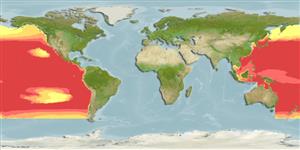Thunnus orientalis (Temminck & Schlegel, 1844)
Pacific bluefin tuna
Add your observation in Fish Watcher
| Native range | All suitable habitat | Point map | Year 2050 |

|
| This map was computer-generated and has not yet been reviewed. |
| Thunnus orientalis AquaMaps Data sources: GBIF OBIS |
Upload your photos and videos
Pictures | Google imageThunnus orientalis
Picture by FAO
Pictures | Google imageThunnus orientalis
Picture by FAO
Common names from other countries
Classification / Names आम नाम | उपशब्द | Catalog of Fishes(वर्ग, प्रजाति) | ITIS | CoL | WoRMS | Cloffa
> Scombriformes (Mackerels) > Scombridae (Mackerels, tunas, bonitos) > Scombrinae
Etymology: Thunnus: Greek, thynnos = tunna (Ref. 45335).
More on authors: Temminck & Schlegel.
Etymology: Thunnus: Greek, thynnos = tunna (Ref. 45335).
More on authors: Temminck & Schlegel.
Environment: milieu / climate zone / depth range / distribution range पारिस्थितिकी
समुद्री; खारा; औशिनोड़िरोमस (Ref. 51243); गहराई सीमा 1 - 550 m (Ref. 58302). Subtropical; 61°N - 52°S, 99°E - 70°W
वितरण देश | ऐफ ऐ ओ क्षेत्र | Ecosystems | संयोग | Point map | भूमिका | Faunafri
North Pacific: Gulf of Alaska to southern California and Baja California and from Sakhalin Island in the southern Sea of Okhotsk south to northern Philippines. There are four substantiated records of this subspecies in the southern hemisphere: off Western Australia, southeast Pacific (37°11'S, 114°41'W) and Gulf of Papua (Ref. 10997). The species occurs mainly in the northern Pacific but ventures into New Zealand waters for at least three months during spring and early summer (Ref. 83312).
आकार / वज़न / Age
Maturity: Lm ? range ? - ? cm
Max length : 300 cm FL पुल्लिंग / अलिंग; (Ref. 9340); common length : 200 cm FL पुल्लिंग / अलिंग; (Ref. 9340); अधिकतम प्रकाशित वज़न: 450.0 kg (Ref. 47525); अधिकतम सूचित उम्र: 15 वर्षो (Ref. 83312)
Max length : 300 cm FL पुल्लिंग / अलिंग; (Ref. 9340); common length : 200 cm FL पुल्लिंग / अलिंग; (Ref. 9340); अधिकतम प्रकाशित वज़न: 450.0 kg (Ref. 47525); अधिकतम सूचित उम्र: 15 वर्षो (Ref. 83312)
Short description पहचान कुंजी | आकृति विज्ञान | मौरफोमैटरिक्स
Mean number of gill rakers 35.9. First ventrally directed parapophysis on vertebra number 8. Dorsal wall of body cavity has a narrow bulge with lateral concavity and wide lateral trough. Caudal keels dark.
Epipelagic, usually oceanic, but seasonally coming close to shore (Ref. 168). Tolerates ample temperature intervals (Ref. 168). Forms schools by size, sometimes with other scombrids (Ref. 168). Migrates between June and September in a northward direction along the coast of Baja California, Mexico and California (Ref. 168). A voracious predator that feeds on a wide variety of small schooling fishes and squids, also on crabs crabs and to a lesser degree on sessile organisms (Ref. 168). Marketed fresh and frozen.
Life cycle and mating behavior परिपक्व अवधि | पुनरुत्पत्ति | मछलीऔ का अंडे देना | अंडे | Fecundity | लार्वा
Main reference
Upload your references | संदर्भ | संयोजक : Collette, Bruce B. | सहयोगीयो
Collette, B.B., 1995. Scombridae. Atunes, bacoretas, bonitos, caballas, estorninos, melva, etc. p. 1521-1543. In W. Fischer, F. Krupp, W. Schneider, C. Sommer, K.E. Carpenter and V. Niem (eds.) Guia FAO para Identification de Especies para lo Fines de la Pesca. Pacifico Centro-Oriental. 3 Vols. FAO, Rome. (Ref. 9340)
IUCN Red List Status (Ref. 130435: Version 2024-2)
Near Threatened (NT) (A2bd); Date assessed: 15 January 2021
Threat to humans
Harmless
Human uses
मात्स्यिकी: उच्च वाणिज्य; जलीयकृषि: व्यापारिक; आखेट मत्स्य: हां
FAO(Aquaculture systems: production; मात्स्यिकी: production; publication : search) | FIRMS (Stock assessments) | FishSource | Sea Around Us
अधिक जानकारी
Population dynamics
Growth parameters
Max. ages / sizes
Length-weight rel.
Length-length rel.
Length-frequencies
Mass conversion
भर्ती
बहुतायत
Growth parameters
Max. ages / sizes
Length-weight rel.
Length-length rel.
Length-frequencies
Mass conversion
भर्ती
बहुतायत
Life cycle
पुनरुत्पत्ति
परिपक्व अवधि
Fecundity
मछलीऔ का अंडे देना
Spawning aggregations
अंडे
Egg development
लार्वा
लारवल गतिकी
पुनरुत्पत्ति
परिपक्व अवधि
Fecundity
मछलीऔ का अंडे देना
Spawning aggregations
अंडे
Egg development
लार्वा
लारवल गतिकी
Anatomy
गिल क्षेत्र
Brain
Otolith
गिल क्षेत्र
Brain
Otolith
Physiology
Body composition
Nutrients
Oxygen consumption
Swimming type
Swimming speed
Visual pigments
Fish sound
Diseases & Parasites
Toxicity (LC50s)
Body composition
Nutrients
Oxygen consumption
Swimming type
Swimming speed
Visual pigments
Fish sound
Diseases & Parasites
Toxicity (LC50s)
Genetics
आनुवंशिकी
Heterozygosity
हैरेटिबिलटी
आनुवंशिकी
Heterozygosity
हैरेटिबिलटी
Human related
Aquaculture systems
जलीयकृषि रूपरेखाऐ
खींच
Ciguatera cases
Stamps, coins, misc.
Aquaculture systems
जलीयकृषि रूपरेखाऐ
खींच
Ciguatera cases
Stamps, coins, misc.
साधन
E-book | कार्यक्षेत्र पथप्रदर्शक | लंबाई आवृति इंद्रजालिक | जीवन-इतिहास उपकरण | बिन्दु नक्शा | Classification Tree
| Catch-MSY |
Special reports
Download XML
Summary page | Point data | आम नाम | Photos
इंटरनेट स्रोत
Aquatic Commons | BHL | Cloffa | BOLDSystems | Websites from users | Check FishWatcher | CISTI | Catalog of Fishes(वर्ग, प्रजाति) | DiscoverLife | ECOTOX | Faunafri | Fishtrace | GenBank(genome, nucleotide) | GloBI | GOBASE | | Google Books | Google Scholar | Google | IGFA World Record | MitoFish | राष्ट्रीय आंकड़ासंचय | Otolith Atlas of Taiwan Fishes | PubMed | Reef Life Survey | Scirus | SeaLifeBase | Tree of Life | Wikipedia(Go, खोज) | World Records Freshwater Fishing | Zoological Record
Estimates based on models
Preferred temperature (Ref. 115969): 13.9 - 28.1, mean 24.3 (based on 983 cells).
Phylogenetic diversity index (Ref. 82804): PD50 = 0.5039 [Uniqueness, from 0.5 = low to 2.0 = high].
Bayesian length-weight: a=0.01380 (0.00641 - 0.02973), b=3.03 (2.86 - 3.20), in cm Total Length, based on LWR estimates for this Genus-body shape (Ref. 93245).
Trophic level (Ref. 69278): 4.5 ±0.3 se; based on size and trophs of closest relatives
लौटाव (Ref. 120179): माध्यम, न्यूनतम जनसंख्या दुगनी होने का समय 1.4 - 4.4 वर्ष। (tm=3-5; tmax=15; K=0.1-0.2).
Prior r = 0.25, 95% CL = 0.17 - 0.38, Based on 3 full stock assessments.
Fishing Vulnerability (Ref. 59153): Very high vulnerability (76 of 100).
Climate Vulnerability (Ref. 125649): Moderate vulnerability (38 of 100).




